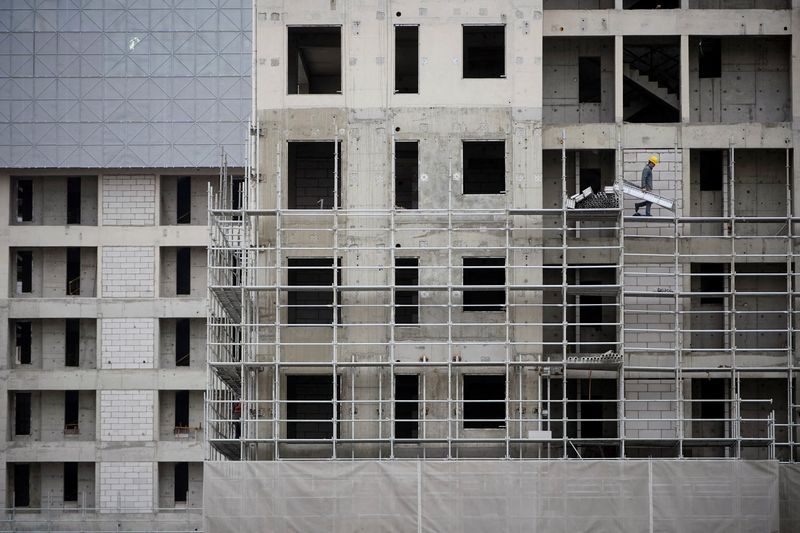BEIJING (Reuters) – China is counting on revived infrastructure spending to support its slowing economy, but controls over local government debt risks and falling investment returns could hamper the renewed push, policy insiders and economists said.
As pressure grows from a deepening property market slump and the country’s strict zero-COVID policy, Chinese leaders are once again turning to infrastructure to drive growth, after a year when they focused on curbing debt and housing risks.
Stability trumps everything ahead of a key once-in-five-years Communist Party congress later this year, with policymakers looking to ward off a sharper slowdown in the world’s second-largest economy that could undermine job creation.
At a meeting in December to chart the course for 2022, top leaders called for front loading infrastructure investment to help cushion the slowdown, which looks set to worsen in the first half.
“We need to step up infrastructure investment and stabilize the property sector,” Yao Jingyuan, an adviser to the cabinet, told Reuters. “The downward pressure on the economy is big this year and the employment pressure is big.”
This month, Premier Li Keqiang pledged faster investment in 102 key infrastructure projects, including in transportation, logistics and telecommunications as well as advanced manufacturing and high-tech, under the country’s the 14th five-year plan (2021-25).
Local governments, meanwhile, have unveiled their own infrastructure projects, including in Shanghai and the provinces of Sichuan, Jiangsu,Zhejiang, Anhui and Hebei.
However, any rush to launch such projects could reignite debt concerns, even as Beijing keeps checks on local government borrowing and requires sustainable investment returns.
In 2008-2009, a 4 trillion yuan ($629 billion) spending package largely shielded China’s economy from the global financial crisis but saddled local governments and state firms with mountains of debt.
“We should try our best to reduce the side effects of economic stimulus policies,” Yao said.
LOOKING TO NEW AREAS
China’s fixed-asset investment grew 4.9% in 2021 from a year earlier, the second-weakest pace since 1996 when official data started. Growth was 2.9% in COVID-ravaged 2020.
Infrastructure investment rose just 0.4% in 2021, though analysts at HSBC predict it will expand 5% this year as Beijing looks to ease financing bottlenecks and focuses on new growth drivers.
With traditional projects like highways, railways and airports facing falling investment returns and reaching saturation point, China has been trying to expand new infrastructure focused on 5G, artificial intelligence, and data.
The finance ministry has already issued 1.46 trillion yuan in its 2022 advance quota for local government special bonds, on top of 1.2 trillion yuan in unspent bond funds from the fourth quarter of 2021 – part of the 2021 quota of 3.65 trillion yuan.
Vice Finance Minister Xu Hongcai said last month that the new quota will prioritise key projects and regions with lower debt burdens, while strictly controlling local governments’ hidden debt to fend off systemic risks.
But after decades of break-neck construction and credit-fuelled investment, new projects may offer less economic bang for the buck.
“The problem at the present is that we have enough money but don’t have enough good projects,” said a government adviser who spoke on condition of anonymity.
MOVING TO STABILIZE PROPERTY SECTOR
To revive construction, authorities have been trying to restore stability to the ailing property sector, marginally easing financing curbs for property developers and speeding up mortgage issuance for home buyers.
But few analysts expect a major turnaround in the sector soon, with HSBC forecasting zero to 2% growth in property investment this year.
A ramp-up in public housing developments could also be on the cards. Such spending was often deployed during past downturns.
Moreover, the central bank has started cutting interest rates and pumping more cash into the financial system to bring borrowing costs down, with further modest easing steps expected in coming months.
“We should not allow the property market to sink for a long time because it’s related to many industries,” Li Yang, former vice president of the Chinese Academy of Social Sciences, a top government think tank, told a media briefing last week.
China will be able to achieve economic growth of around 5.5% in 2022, an adviser to the cabinet said last week, a rosier prediction than markets expect.
The IMF this week forecast China’s growth this year at 4.8%.
“We expect Beijing to significantly speed up investment in national infrastructure projects, though the size is unlikely to be sufficient to stabilize growth,” Ting Lu, chief China economist at Nomura, said in a note.
Lu said China should move to spur consumption by ramping up subsidies for households during the pandemic.
($1 = 6.3206 Chinese yuan renminbi)
(Reporting by Kevin Yao; Editing by Kim Coghill)






















